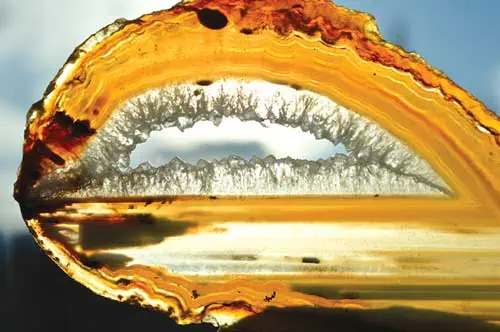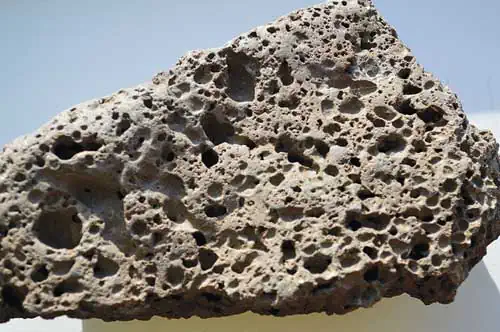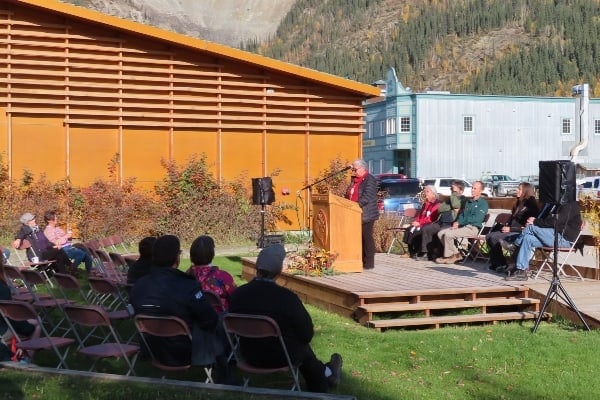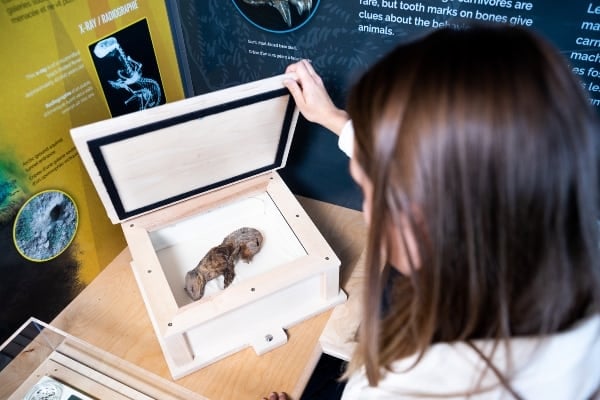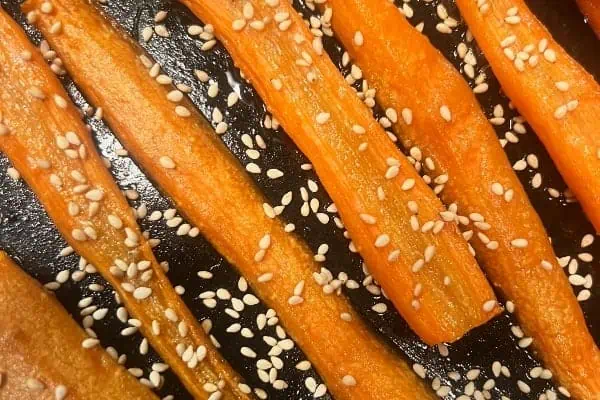Quartz is everywhere; it is the second most common mineral making up the Earth’s crust, just behind feldspar. Quartz is composed of the two elements silicon and oxygen. It has many different forms. Single quartz crystals can be over two metres long. When quartz crystals are microscopic, the mineral is called chalcedony. When chalcedony has multi-coloured bands or funky designs, it is called agate or jasper. You can readily see through thin slices of agate, whereas jasper is more translucent.
Certain rocks around Carmacks contain agate and jasper and there are established walking trails to easily access these locations. Agate is a semi-precious stone found around the world. It is not rare like diamonds, emeralds, or rubies, but it can be very beautiful. Each agate is unique. Most show amazingly intricate and colourful designs.
In order for agates to form you need a couple of things. First they need a place to start. Then they need the right mineral rich fluids feeding them so they can grow. Most agates are found in the rocks from volcanic lava – a rock called basalt. It is usually a dark brown colour around the Yukon. If you been to the island of Hawaii and walked on some of the more recent lava flows you know basalt can be very black, as well.
Basalt usually comes from magma, the hot liquid part of the earth 20 kilometres down. As the basalt rises from below, the pressure releases as it gets closer to the surface. Gases normally dissolved at depth start to form into bubbles in the lava.
This is the same thing that happens to your ginger ale when you open the can. The pressure is released and bubbles suddenly appear in your drink, seemingly coming out of nowhere. In basalts the gases are mostly water vapour (steam) and carbon dioxide. Other gases could include sulphur compounds, which give that rotten egg smell associated with some volcanoes.
When the basalt hardens there are holes in the rock, just like Swiss cheese. This texture is known as “vesicular,” from the word vesicle. In basalt these vesicles can be anywhere from microscopic size to several centimetres across, and larger.
The basalts around Carmacks are appropriately named the Carmacks Group Volcanics and are about 70 million years old. That is old compared to the Miles Canyon basalts in Whitehorse, which are only about 8 million years old.
The Carmacks basalts are thought to have formed where Yellowstone is now. Due to continental movement over those 70 million years, they have now ended up in the Yukon. Old Faithful and the other numerous Yellowstone hot springs are remnants of what was once a very active volcanic area.
Once the Carmacks basalts cooled, heated groundwater from below picked up minerals from the surrounding rocks as the fluids rose to the surface. They circulated easily through the porous basalts and filled some of the voids in the rocks. These fluids would have been about the same temperature as the water at the hot end of Liard Hot Springs.
In the case of the Carmacks basalt, the water filling some of these voids contained a high concentration of quartz (silica) molecules in solution. Very tiny solid crystals start forming on the walls of the cavity and slowly build up in concentric patterns out from the walls towards the centre. The different coloured bands are due to different minerals that are in solution at the time. Changes in temperature or pressure will also affect what each layer will look like, thus the unique patterns.
Sometimes there isn’t enough growth to completely fill the cavity and there is nothing in the centre. When this happens the rocks are known as geodes. (There are some of those at Carmacks, as well.) Others may be filled with calcium or other minerals rather than quartz.
Local agates were used by some of the first people who came to the Carmacks area. Around 10,000 years ago the indigenous peoples possessed what was known as microblade technology. They had the knowledge and ability to fashion stone into tools and blades that were used for hunting, cutting and skinning.
Archaeology studies by the Yukon Heritage Branch in the 1980s and ’90s in the Frenchman Lake area excavated a knapping site used by those long-ago ancestors of today’s Little Salmon Carmacks First Nation citizens. This site has been roughly dated as being used between 4,500 and 10,000 years ago.
Knapping is the process of making these rock blades out of a piece of raw stone that the people had obtained from a nearby source. One or more knappers would sit around and fabricate these tools at sites used specifically for that purpose. There are some fascinating videos on YouTube of modern day knappers reproducing blades using the methods of the early indigenous tool makers.
At the Frenchman Lake site, hundreds of blades and fragments were found. The most common were made of a black and grey rock called chert, but there were also some made from Carmacks agates. Chert is a very fine grained, hard, brittle rock composed mostly of quartz. There is a small outcrop of black chert near the Nordenskiold River, south of Carmacks that could possibly be the source.
There have been red Carmacks agate pieces found at a Ta’an Kwäch’än archaeological site near Fox Lake, as well as some at Fort Selkirk.
Agate has for centuries been considered a “crystal” of great healing properties. Such as eliminating bad dreams and stress, or bringing spiritual balance. Even different colours of agate or those from certain areas are said to have specific powers. Botswana agate is supposed to be good to help you stop smoking. Blue agate with white patterns will help soften someone’s stubborn streak.
Around Carmacks the agate trails will take you to the grey-brown basalts that host the agate and jasper. You will have to poke around at the crumbly basalt or look in the piles of rock that accumulate at the base of outcrops to find some treasure. Always wear safety eye protection if you are banging on rocks.
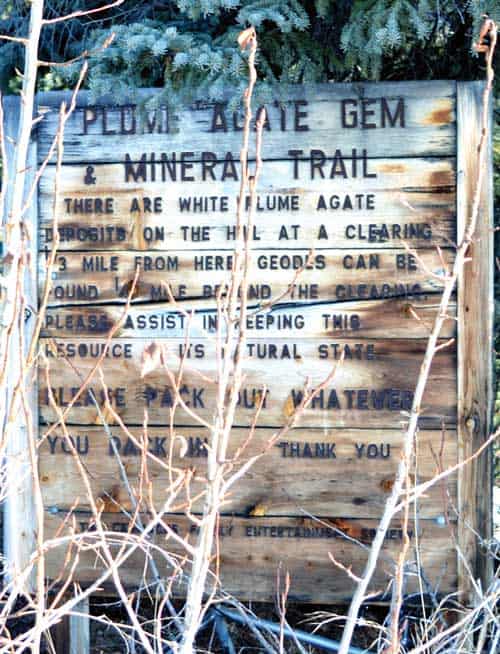
- Miller Ridge Trail
This trail is about 4 kilometres down the Mount Nansen Road on the right hand side. The Nansen road is the first left after crossing the Nordenskiold River on River Drive through Carmacks. The trail is about a two to three hour round trip. The area is known for its red jasper and Miller Ridge itself has interesting rock formations. - Charlie Lake Trail
This trail is about 6 kilometres down the Mount Freegold Road (which is straight ahead as you cross the Nordenskiold bridge), on the left side . It is about a 5 kilometre long trail. - Plume Agate Trail
This trail is 14 kilometres south of Carmacks at about kilometre 344 of the North Klondike Highway, on the east side of the highway. Plume agate is a type of agate that has swirling and feather like patterns. - Cliffside Agate Trail
This trail is approximately five kilometres north of Carmacks, on the west side of the North Klondike highway. This trail also has beautiful views of the Yukon River as it winds below.
For more information on the agate trails in the Carmacks area, contact the Village of Carmacks at 867-863-6271 or the Tagé Cho Hudän Interpretive Centre at 867-863-5831.

